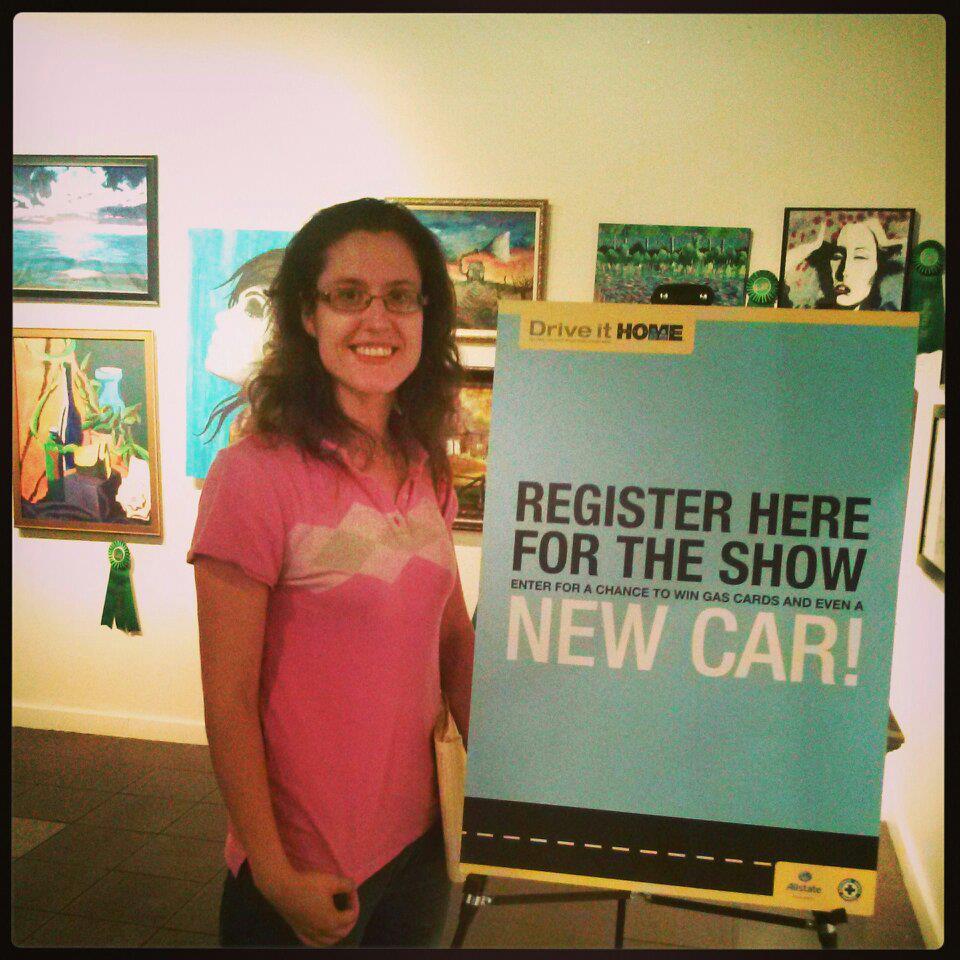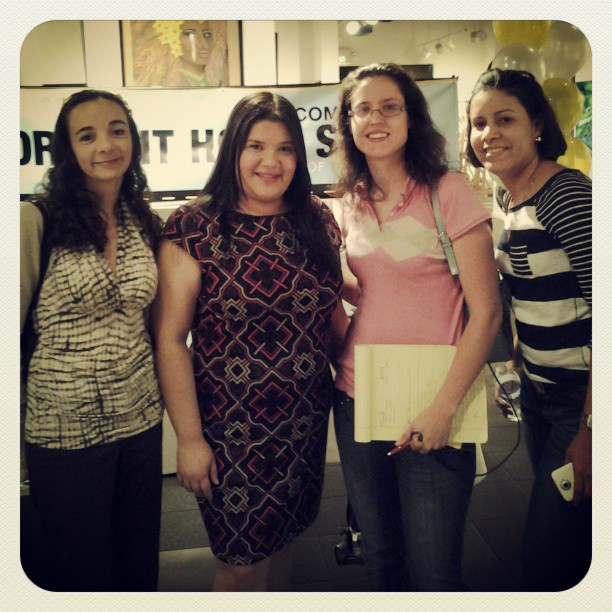
Last week, I had the lovely opportunity to enjoy a solo road trip across Florida in order to attend the Drive It Home event in Ft. Myers. It took about three hours to get there thanks to traffic, but I have never actually been there before. Here’s me by the registration booth:
Here’s a bit of background on the new Drive It Home program: It was recently launched by the NSC with the help of the Allstate Foundation. It was founded to educate parents on driving risks and offers them specially created resources to help keep their teens safer on the road, especially after a teen gets a driver’s license. It is designed by parents for parents and includes an interactive website – driveithome.org – featuring engaging videos, practice tips and other valuable resources. As part of Drive it Home, the Drive It Home Show has been stopping in 14 cities across the country giving parents a fun look at the serious subject of teen driving. The show features the comedians of world renowned Second City Communications and safety experts as they help parents understand the real hazards teens face on the road, better coach teen drivers and learn about state teen driving laws.
So let’s get back to the actual event. Despite the drive, I am glad I went because not only did I get to see new sites, I also had the opportunity to learn a few things. Yes the event was targeting parents of teens, but I learned some things that I could even use right now with my preschoolers. Plus I know many of my followers have children and teens that the information would be valuable to. For instance, How long does driver’s ed last? It is usually about 16 years or so, because your kids are watching you every time they get in the car with you.
At the event, we heard the story of Maryann and her son Luke. Luke was just 15 years old when he got into an accident the day before Valentine’s Day. On Valentine’s Day, he was brain dead. He was buried on February 18th, the day before his 16th birthday. Luke was not the driver. He was looking for a quick ride home and hopped into the car with a friend who decided to go off-roading (rather than bringing him straight home, which was only 5 minutes away). This young driver had also been seen in the past driving recklessly. Truth is that most young drivers need additional training even after they get their license.
I got my license in NY, which only grants a Junior License at 16 and you can only get a Senior License at 17 if you have taken driver’s ed. Fortunately, I took driver’s ed and received a lot of training both before and afterward. I remember driving once with friends in the car and music playing loudly, and I made a U-turn at a light on a road in which U-turns were apparently illegal. I was pulled over and I remember the cop disciplining me for having too many distractions. Fortunately he cut me a break. However, there are many teens out there driving with their friends, listening to music, distracted by texting & tweeting (which practically in my days); and no one is there to make sure they are driving safely. You, as parents, can help reduce the risk for your children by taking an active role in your child or teen’s driving education. You can start young by changing how you drive to model safer behavior. You can still practice discipline with your teen even after he or she gets a license. To illustrate my point you can watch this Youtube video of teens talking about their parent’s driving behavior.
Here are also some facts & tips I learned while at the event:
- You should avoid purchasing a high performance vehicle for your teen, as their inexperience can get them injured or killed behind the wheel of a powerful vehicle.
- Teens should not ride with other teens, unless they know their driving practices are safe.
- When your teen is learning to drive, you should let them practice in paths they would normally travel, rather than just the parking lot.
- Even after they get a license, you should continue to practice with them. “One of the most dangerous years in a person’s life is the first 12 months after getting a driver’s license. Annually, there are about two million teens under the age of 18 in their first year of driving on U.S. roads, the National Safety Council (NSC) reports.”
- Pre-teens ages 12-15 are especially focused on driving and at the age of 16, belt use goes dramatically down. This is when they usually begin driving themselves.
I even learned some Florida facts too!:
- Parents believe that risk-taking is the primary cause of crashes, when inexperience is the real issue. Only 16% of Florida parents say a teen’s lack of driving experience is the top cause of crashes. The national average is 18%.
- Parents say it’s very important for their teen to learn a variety of skills behind the wheel, but aren’t teaching their teen to manage the highest risk driving situations.Nearly 38% of parents in Florida are not covering how to manage the deadly risks – such as nighttime driving and driving with young passengers – with their teens. Oddly enough, parents and teens agree that they should have spent more time practicing in dangerous conditions, according to The Allstate Foundation.
In addition to the driveithome.org website, you can also visit the Florida Teen Safe Driving Coalition at http://www.nsc.org/FLteens-GDL4U.
It was definitely an eye opening event and I am glad I trekked cross-state for it.
Photo credit: Maybelline Valenti
Bonus: I also got a chance to hang out with fellow bloggers Paula Bendfeldt-Diaz, Maybelline Valenti, Heather Lopez (me) and Alejandra Ramirez Castro. I’ve had a group over there for over a year and this was the first time I visited them where they live.
I was selected for this opportunity as a member of Clever Girls Collective, and the content and opinions expressed here are all my own.



Leave A Comment